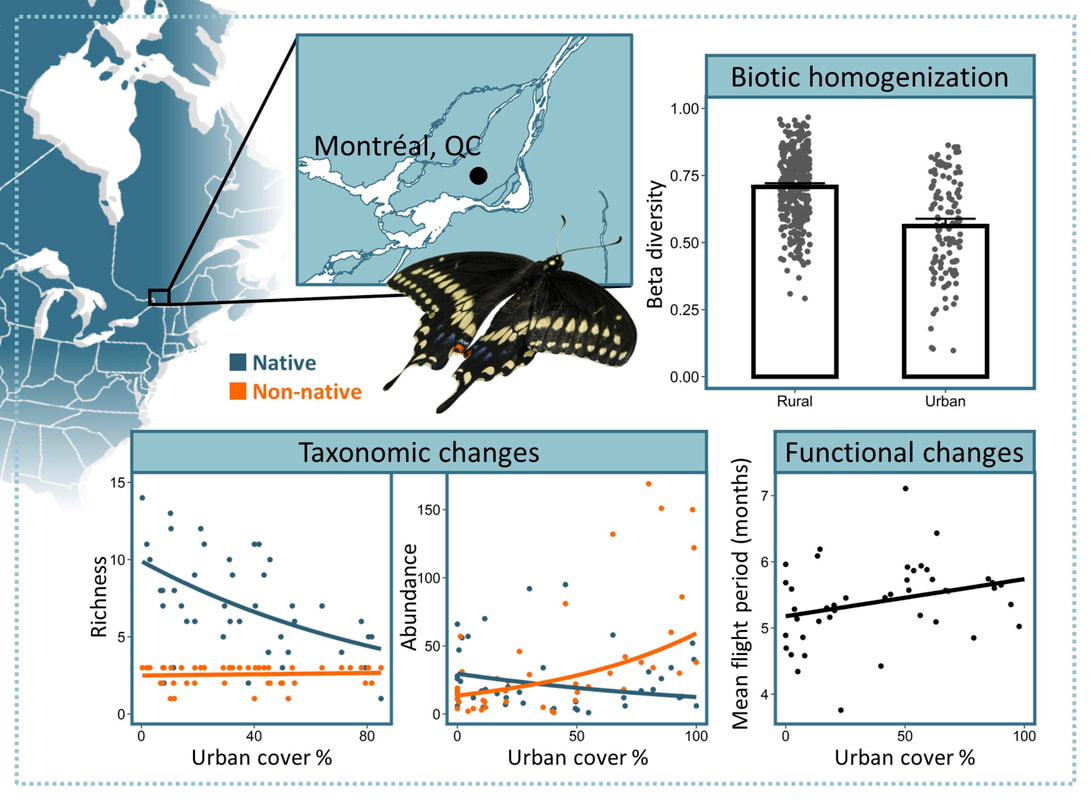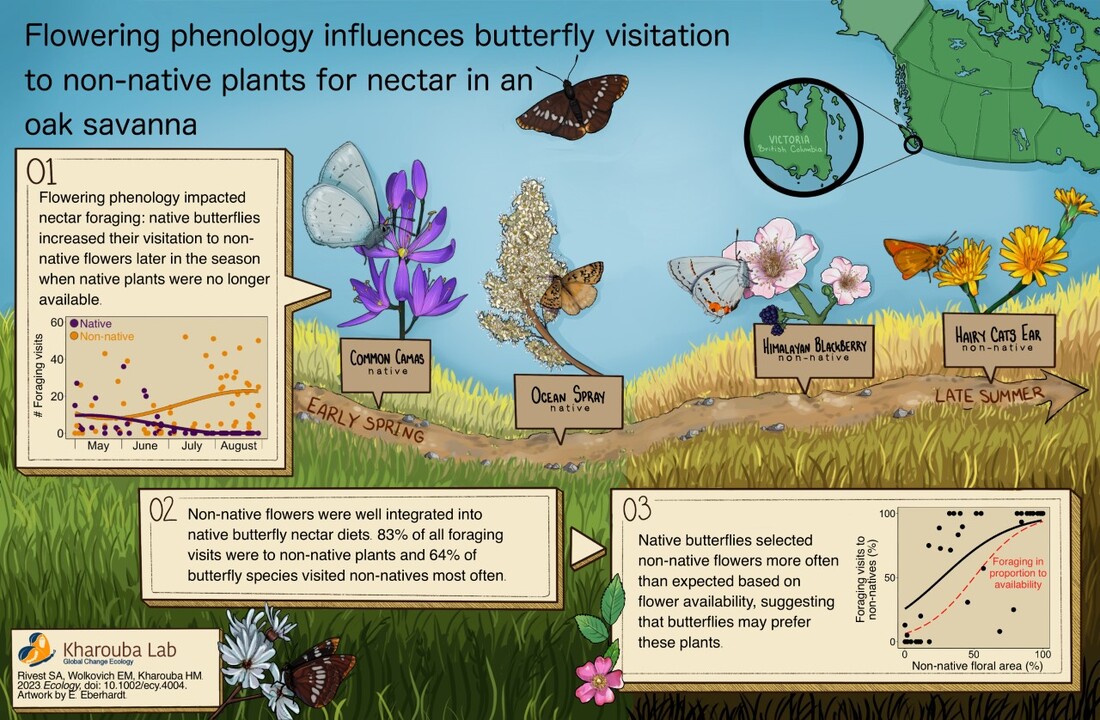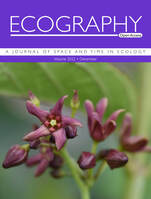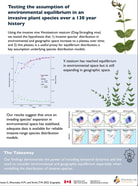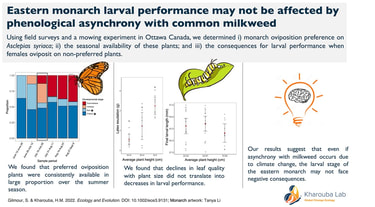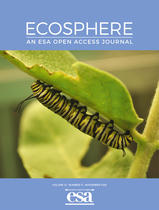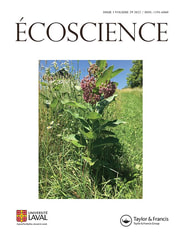Publications
For a full list of papers and citations see: Heather Kharouba's Google Scholar profile.
Underlined authors are/were students or postdocs in the lab.
Underlined authors are/were students or postdocs in the lab.
Keefe, H. and Kharouba, H.M. 2024. Growing degree-days do not explain moth species distributions at broad scales. Ecosphere. link
|
Kharouba, H.M. 2024. Shifting the paradigm: the role of introduced plants in the resiliency of terrestrial ecosystems to climate change. Global Change Biology. link
|
Kharouba, H.M. and Williams, J.L. 2024. Forecasting species' responses to climate change using space-for-time substitution. Trends in Ecology & Evolution. link pdf
Kharouba, H.M. 2024. (Editorial) Now is the time for academics to think and act beyond academia. FACETS link
Kharouba, H.M. 2024. (Editorial) Now is the time for academics to think and act beyond academia. FACETS link
|
Rivest, S.A., and Kharouba, H.M. 2024 Taxonomic and functional homogenization of butterfly communities along an urban gradient. Insect Conservation and Diversity. https://doi.org/10.1111/icad.12729
|
Kharouba, H.M, and Wolkovich, E.M. 2023. Lack of evidence for the match-mismatch hypothesis across terrestrial trophic interactions. Ecology Letters.
Robinson, M.L. +191 co-authors (incl. Kharouba, H.M.) 2023. Plant size, latitude, and phylogeny explain within-population variability in herbivory. Science, 382(6671), 679-683.
Reich, M.S., Kindra, M.K., Dargent, F., Hu, L., Flockhart, D.T.T, Norris, D.R., Kharouba, H.M., Talavera, G., and Bataille, C.P. 2023. Metals and metal isotopes in insect wings: Implications for diet, geolocation and pollution exposure. Frontiers in Ecology and Evolution. Press release
Robinson, M.L. +191 co-authors (incl. Kharouba, H.M.) 2023. Plant size, latitude, and phylogeny explain within-population variability in herbivory. Science, 382(6671), 679-683.
Reich, M.S., Kindra, M.K., Dargent, F., Hu, L., Flockhart, D.T.T, Norris, D.R., Kharouba, H.M., Talavera, G., and Bataille, C.P. 2023. Metals and metal isotopes in insect wings: Implications for diet, geolocation and pollution exposure. Frontiers in Ecology and Evolution. Press release
|
Rivest, S.A., Wolkovich, E.M., Kharouba, H.M. 2023. Flowering phenology influences butterfly visitation to non-native plants for nectar in an oak savanna. Ecology.
|
|
Foster, S., Kharouba, H.M., and Smith, T.W. 2022. Testing the assumption of environmental equilibrium in an invasive plant species over a 130 year history. Ecography. http://doi.org/10.1111/ecog.06284. graphical abstract more about cover
Plain language summary here: pdf |
|
Gilmour, S. and Kharouba, H.M. 2022. Eastern monarch larval performance may not be affected by shifts in phenological synchrony with milkweed. Ecology and Evolution. paper (graphical abstract)
|
|
Kharouba, H.M. and Yang, L.H. 2021. Disentangling the direct, indirect and combined effects of experimental warming on a plant-insect herbivore interaction. Ecosphere 12:e03778. https://doi.org/10.1002/ecs2.3778.
COVER PHOTO: Monarch (Danaus plexippus) larvae are voracious herbivores in their final stage of larval development. In a series of laboratory experiments, we tested for direct, indirect, and combined effects of warming on a critical part of the monarch–milkweed interaction. Even in a relatively simple, short-term experiment, we found variability among these different effects of warming that highlights challenges for predicting the broader effects of climate warming on ecological communities. Photo credit: H. Kharouba. |
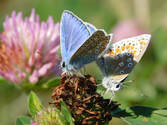 Photo: S. Rivest
Photo: S. Rivest
Rivest, S.A. and Kharouba, H.M. 2021. Anthropogenic disturbance promotes the abundance of a newly introduced butterfly in Canada, Polyommatus icarus (Lepidoptera: Lycaenidae). Canadian Journal of Zoology. pdf Press release. Interview on CBC Ottawa Morning show. Article in Le Devoir
|
Lalonde, S., McCune, J.L., Rivest, S.A., and Kharouba, H.M. 2021. Decline in common milkweed along roadsides around Ottawa, Canada. Écoscience. pdf
COVER PHOTO: A flowering roadside milkweed plant from 2017 from a site east of Ottawa, Ontario, Canada. Photo credit: H. Kharouba |
Tremblay, P.T., MacMillan, H.A., and Kharouba, H.M. 2021. Autumn larval cold tolerance does not predict the northern range limit of a widespread butterfly species. Ecology and Evolution. pdf
Dargent, F., Gilmour, S.M., Brown, E.A., Kassen, R. and Kharouba, H.M. 2021. Low prevalence of the parasite Ophryocystis elektroscirrha at the range edge of the eastern North American monarch (Danaus plexippus) butterfly population. Canadian Journal of Zoology. pdf
2015-2020
Kharouba, H.M. and Wolkovich, E.M. 2020. Disconnects between ecological theory and data in phenological mismatch research. Nature Climate Change, 10:406-415. doi: 10.1038/s41558-020-0752-x (pdf)
---- Click here for associated blog post for Nature Ecology & Evolution
McCune, J.L., Roser-Katz, H., Bennett, J.R., Schuster, R., & Kharouba, H.M. 2020. Do traits of plant species predict the efficacy of species distribution models for finding new occurrences? Ecology and Evolution, 00:1-14. DOI:10.1002/ece3.6254 (pdf)
Radchuk, V. + 64 co-authors (incl. Kharouba, H.M). 2019. Adaptive responses of animals to climate change are most likely insufficient. Nature Communications 10: 3109.
Panchen, Z.A., Doubt, J.M, Kharouba, H.M., and Johnston, M.O. 2019. Patterns and biases in an Arctic herbarium specimen collection: implications for phenological research. Applications in Plant Sciences 7:e1229. Special Issue: “Emerging Frontiers in Plant Phenology” (pdf)
Chmura, H.E., Kharouba, H.M., Ashander, J., Ehlman, S.M., Rivest, E.B., and Yang, L.H. 2019. The mechanisms of phenology: the patterns and processes of phenological shifts. Ecological Monographs 89:e01337 DOI: 10.1002/ecm.1337 (pdf)
Kharouba, H.M., Lewthwaite, J.M.M., Guralnick, R., Kerr, J.T., and Vellend, M. 2018. Using insect natural history collections to study global change impacts: challenges and opportunities. Theme Issue: Biological collections for understanding biodiversity in the Anthropocene. Philosophical Transactions B 374: 20170405 (pdf).
Kharouba, H.M., Ehrlen, J., Gelman, A., Bolmgren, K., Allen, J., Travers, S. and E.M. Wolkovich. 2018. Global shifts in the phenological synchrony of species interactions over recent decades. PNAS 115:5211-5216 (pdf) Commentary; Media coverage: National Post, CBC Radio-Canada, New York Times
Buckley, L.B., Arakaki, A.J., Cannistra, A.F., Kharouba, AH.M. and Kingsolver, J.G. 2017. Insect development, thermal pasticity and fitness implications in changing, seasonal environments. Integrative and Comparative Biology, icx032. pdf
Wetzel, W.C., Kharouba, H.M., Robinson, M., Holyoak, M. and Karban, R. 2016. Variance in plant nutritive traits reduces the performance of insect herbivores. Nature 539:425.. doi: 10.1038/nature20140 (data)
Dargent, F., Gilmour, S.M., Brown, E.A., Kassen, R. and Kharouba, H.M. 2021. Low prevalence of the parasite Ophryocystis elektroscirrha at the range edge of the eastern North American monarch (Danaus plexippus) butterfly population. Canadian Journal of Zoology. pdf
2015-2020
Kharouba, H.M. and Wolkovich, E.M. 2020. Disconnects between ecological theory and data in phenological mismatch research. Nature Climate Change, 10:406-415. doi: 10.1038/s41558-020-0752-x (pdf)
---- Click here for associated blog post for Nature Ecology & Evolution
McCune, J.L., Roser-Katz, H., Bennett, J.R., Schuster, R., & Kharouba, H.M. 2020. Do traits of plant species predict the efficacy of species distribution models for finding new occurrences? Ecology and Evolution, 00:1-14. DOI:10.1002/ece3.6254 (pdf)
Radchuk, V. + 64 co-authors (incl. Kharouba, H.M). 2019. Adaptive responses of animals to climate change are most likely insufficient. Nature Communications 10: 3109.
Panchen, Z.A., Doubt, J.M, Kharouba, H.M., and Johnston, M.O. 2019. Patterns and biases in an Arctic herbarium specimen collection: implications for phenological research. Applications in Plant Sciences 7:e1229. Special Issue: “Emerging Frontiers in Plant Phenology” (pdf)
Chmura, H.E., Kharouba, H.M., Ashander, J., Ehlman, S.M., Rivest, E.B., and Yang, L.H. 2019. The mechanisms of phenology: the patterns and processes of phenological shifts. Ecological Monographs 89:e01337 DOI: 10.1002/ecm.1337 (pdf)
Kharouba, H.M., Lewthwaite, J.M.M., Guralnick, R., Kerr, J.T., and Vellend, M. 2018. Using insect natural history collections to study global change impacts: challenges and opportunities. Theme Issue: Biological collections for understanding biodiversity in the Anthropocene. Philosophical Transactions B 374: 20170405 (pdf).
Kharouba, H.M., Ehrlen, J., Gelman, A., Bolmgren, K., Allen, J., Travers, S. and E.M. Wolkovich. 2018. Global shifts in the phenological synchrony of species interactions over recent decades. PNAS 115:5211-5216 (pdf) Commentary; Media coverage: National Post, CBC Radio-Canada, New York Times
Buckley, L.B., Arakaki, A.J., Cannistra, A.F., Kharouba, AH.M. and Kingsolver, J.G. 2017. Insect development, thermal pasticity and fitness implications in changing, seasonal environments. Integrative and Comparative Biology, icx032. pdf
Wetzel, W.C., Kharouba, H.M., Robinson, M., Holyoak, M. and Karban, R. 2016. Variance in plant nutritive traits reduces the performance of insect herbivores. Nature 539:425.. doi: 10.1038/nature20140 (data)
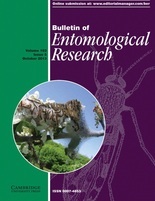
Lee-Yaw, J.A., Kharouba, H.M, Bontrager, M., Mahony, C., Csergő, A.M, Noreen, A.M.E., Li, Q., Schuster, R., and Angert, A.L.. 2016. A synthesis of transplant experiments and ecological niche models suggests that range limits are often niche limits. Ecology Letters 19:710-722. pdf
2010-2015
Karban, R., Grof-Tisza, P., McMunn, M., Kharouba, H.M., and Huntzinger, M. 2015. Caterpillars escape predation in habitat and thermal refuges. Ecological Entomology 40:725-731. pdf
Kharouba, H.M. and Vellend M. 2015. Flowering time of butterfly nectar food plants is more sensitive to temperature than the timing of butterfly adult flight. Journal of Animal Ecology 84:1311-1321. pdf
Kharouba, H.M., Vellend, M., Sarfraz, R. and Myers, J.H. 2015. The effects of experimental warming on the timing of a plant-insect herbivore interaction. Journal of Animal Ecology 84:785-796. pdf
Gilbert, B., Tunney, T.D., McCann, K.S., DeLong, J.P. Vasseur, D.A., Savage, V., Shurin, J.B., Dell, A.I., Barton, B.T., Harley, C.D.G., Kharouba, H.M., Kratina, P., Blanchard, J.L., Clements, C., Winder, M., Greig, H.S. and O’Connor, M.I. 2014. A bioenergetic framework for the temperature dependence of trophic interactions. Ecology Letters 17:891-1052. pdf
Kharouba, H.M., Paquette, S.R., Kerr, J.T and Vellend, M. 2014. Predicting the sensitivity of butterfly phenology to temperature over the past century. Global Change Biology 20:504-514. pdf
Press coverage: press release, Daily Planet (Discovery Channel Canada), Vancouver 24hrs, the Conversation (uk), and related stories: cbc (the National and article)
Vellend, M. and Kharouba, H.M. 2013. Setting conservation priorities when what you see is not what you get. Animal Conservation 16:14-15. (Invited commentary) pdf
Vellend, M., Brown, C., Kharouba, H.M., McCune, J., and Myers-Smith, I. 2013. Historical ecology: using unconventional data sources to test for impacts of global environmental change. American Journal of Botany 100:1294-1305. pdf
Sarfraz, R., Kharouba, H.M., and Myers, J.H. 2013. Tent caterpillars are robust to variation in leaf phenology and quality in two thermal environments. Bulletin of Entomological Research 103:522-529. pdf
Kharouba, H.M., McCune, J.L., Thuiller, W., and Huntley, B. 2013. Do ecological differences between taxonomic groups influence the relationship between species’ distributions and climate? A global meta-analysis using species distribution models. Ecography 36:657-664. pdf Editor's choice
Williams, J.W., Kharouba, H.M., Veloz, S., Vellend, M., McLachlan, J., Liu, Z., Otto-Bliesner, B., and He, F. 2013. The Ice Age Ecologist: Testing Methods for Reserve Prioritization During the Last Global Warming. Global Ecology and Biogeography 22:289-301. pdf Faculty of 1000 “Recommended” (review)
2007-2010
Kharouba, H.M., and Kerr, J.T. 2010. Just passing through: Global change and the conservation of biodiversity in protected areas. Biological Conservation 143:1094-1011. pdf
Kharouba, H.M., Algar, A.C. and Kerr, J.T. 2009. Historically calibrated predictions of butterfly species’ range shift using global change as a pseudo-experiment. Ecology 90:2213-2222. pdf
Algar, A.C., Kharouba, H.M., Young, E.R., and Kerr, J.T. 2009. Predicting the future of species diversity: macroecological theory, climate change, and direct tests of alternate forecasting methods. Ecography 32:22-33. pdf
Kharouba, H.M., Nadeau, J.L., Young, E., and Kerr, J.T. 2008. Using species distribution models to effectively conserve biodiversity into the future. Biodiversity, Special Issue: Global change and biodiversity 9:39-46. pdf
Kerr, J.T., Kharouba, H.M., and Currie, D.J. 2007. The macroecological contribution to global change solutions. Science 316:1581-1584. pdf
Book chapters
Kerr, J.T. and Kharouba, H.M. 2007. Climate change and conservation biology. In: May, R.M. and Maclean, A. (eds). Theoretical Ecology. 3rd edition. Oxford University Press, Oxford, pp 190-204.
2010-2015
Karban, R., Grof-Tisza, P., McMunn, M., Kharouba, H.M., and Huntzinger, M. 2015. Caterpillars escape predation in habitat and thermal refuges. Ecological Entomology 40:725-731. pdf
Kharouba, H.M. and Vellend M. 2015. Flowering time of butterfly nectar food plants is more sensitive to temperature than the timing of butterfly adult flight. Journal of Animal Ecology 84:1311-1321. pdf
Kharouba, H.M., Vellend, M., Sarfraz, R. and Myers, J.H. 2015. The effects of experimental warming on the timing of a plant-insect herbivore interaction. Journal of Animal Ecology 84:785-796. pdf
Gilbert, B., Tunney, T.D., McCann, K.S., DeLong, J.P. Vasseur, D.A., Savage, V., Shurin, J.B., Dell, A.I., Barton, B.T., Harley, C.D.G., Kharouba, H.M., Kratina, P., Blanchard, J.L., Clements, C., Winder, M., Greig, H.S. and O’Connor, M.I. 2014. A bioenergetic framework for the temperature dependence of trophic interactions. Ecology Letters 17:891-1052. pdf
Kharouba, H.M., Paquette, S.R., Kerr, J.T and Vellend, M. 2014. Predicting the sensitivity of butterfly phenology to temperature over the past century. Global Change Biology 20:504-514. pdf
Press coverage: press release, Daily Planet (Discovery Channel Canada), Vancouver 24hrs, the Conversation (uk), and related stories: cbc (the National and article)
Vellend, M. and Kharouba, H.M. 2013. Setting conservation priorities when what you see is not what you get. Animal Conservation 16:14-15. (Invited commentary) pdf
Vellend, M., Brown, C., Kharouba, H.M., McCune, J., and Myers-Smith, I. 2013. Historical ecology: using unconventional data sources to test for impacts of global environmental change. American Journal of Botany 100:1294-1305. pdf
Sarfraz, R., Kharouba, H.M., and Myers, J.H. 2013. Tent caterpillars are robust to variation in leaf phenology and quality in two thermal environments. Bulletin of Entomological Research 103:522-529. pdf
Kharouba, H.M., McCune, J.L., Thuiller, W., and Huntley, B. 2013. Do ecological differences between taxonomic groups influence the relationship between species’ distributions and climate? A global meta-analysis using species distribution models. Ecography 36:657-664. pdf Editor's choice
Williams, J.W., Kharouba, H.M., Veloz, S., Vellend, M., McLachlan, J., Liu, Z., Otto-Bliesner, B., and He, F. 2013. The Ice Age Ecologist: Testing Methods for Reserve Prioritization During the Last Global Warming. Global Ecology and Biogeography 22:289-301. pdf Faculty of 1000 “Recommended” (review)
2007-2010
Kharouba, H.M., and Kerr, J.T. 2010. Just passing through: Global change and the conservation of biodiversity in protected areas. Biological Conservation 143:1094-1011. pdf
Kharouba, H.M., Algar, A.C. and Kerr, J.T. 2009. Historically calibrated predictions of butterfly species’ range shift using global change as a pseudo-experiment. Ecology 90:2213-2222. pdf
Algar, A.C., Kharouba, H.M., Young, E.R., and Kerr, J.T. 2009. Predicting the future of species diversity: macroecological theory, climate change, and direct tests of alternate forecasting methods. Ecography 32:22-33. pdf
Kharouba, H.M., Nadeau, J.L., Young, E., and Kerr, J.T. 2008. Using species distribution models to effectively conserve biodiversity into the future. Biodiversity, Special Issue: Global change and biodiversity 9:39-46. pdf
Kerr, J.T., Kharouba, H.M., and Currie, D.J. 2007. The macroecological contribution to global change solutions. Science 316:1581-1584. pdf
Book chapters
Kerr, J.T. and Kharouba, H.M. 2007. Climate change and conservation biology. In: May, R.M. and Maclean, A. (eds). Theoretical Ecology. 3rd edition. Oxford University Press, Oxford, pp 190-204.


